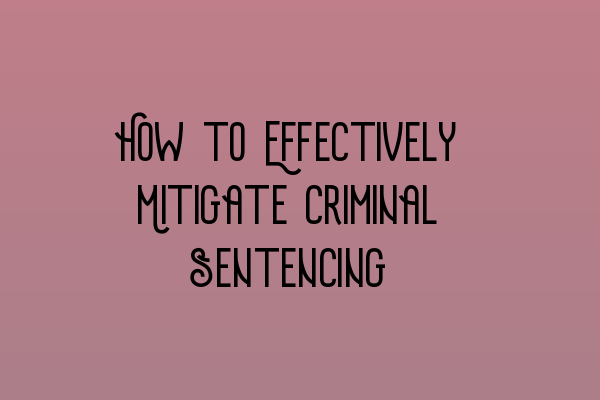How to Effectively Mitigate Criminal Sentencing
When it comes to criminal law and practice, mitigating the potential sentence for your client is of utmost importance. The sentencing of a defendant can have life-altering consequences, so it’s crucial to employ effective mitigation strategies. In this blog post, we will explore some key tips for successfully mitigating criminal sentencing and ensuring the best possible outcome for your client.
1. Thoroughly Assess the Case
Before you begin crafting your mitigation strategy, it’s essential to thoroughly assess the details of the case. Take into account the nature of the offense, any aggravating or mitigating factors, the defendant’s criminal history, and the prevailing sentencing guidelines. This comprehensive understanding will enable you to tailor your mitigation efforts to the specific circumstances of the case.
2. Gather Strong Supporting Evidence
Building a robust mitigation case requires gathering strong and compelling supporting evidence. This evidence should highlight any relevant factors that could potentially lead to a more lenient sentence. Collect character references, testimonials, and any documents or records that demonstrate positive aspects of your client’s life or actions. Providing concrete evidence can greatly strengthen your mitigation arguments.
3. Develop Effective Sentencing Arguments
When presenting your mitigation case to the court, it’s essential to develop persuasive and effective sentencing arguments. This involves articulating how the mitigating factors outweigh the aggravating factors, emphasizing your client’s remorse, rehabilitation efforts, and positive contributions to society. Craft your arguments eloquently and logically, drawing on case law and legal precedents to support your position.
4. Engage with the Sentencing Guidelines
Familiarize yourself with the current sentencing guidelines relevant to the offense in question. Mitigation efforts should align with these guidelines, demonstrating how your client’s case falls within the lower end of the severity spectrum. Engage with the guidelines, highlighting specific factors that warrant a more lenient sentence. It’s essential to show the court that you have thoroughly considered the applicable guidelines and applied them to your client’s case.
5. Consider Pre-Sentence Reports
Pre-sentence reports can play a crucial role in the mitigation process. These reports, prepared by probation officers, provide valuable insights into your client’s background, circumstances, and potential for rehabilitation. It’s important to engage with the preparation of these reports, ensuring that all relevant information is included and accurately reflects your client’s situation. Use the report to highlight factors that support a more lenient sentence and address any concerns or recommendations of the probation officer.
6. Seek Alternative Sentencing Options
When appropriate, explore alternative sentencing options that may be more suitable for your client. This could include community service, rehabilitation programs, or restorative justice initiatives. Presenting viable alternatives to a custodial sentence can significantly impact the court’s decision. Research and familiarize yourself with the available options and assess their suitability for your client’s specific circumstances.
7. Effective Courtroom Presentation
A successful mitigation strategy also involves delivering a well-prepared and persuasive presentation in court. Pay attention to your presentation style, tone, and demeanor. Be respectful and professional, clearly articulating your points and maintaining a persuasive argument throughout. Engage with opposing counsel, respond to the judge’s prompts, and address any concerns or questions raised by the court. Presenting confidently and effectively can greatly enhance the impact of your mitigation efforts.
By employing these effective mitigation strategies, you can increase the likelihood of achieving a more favorable outcome for your client in criminal sentencing. Remember to thoroughly assess the case, gather strong supporting evidence, develop persuasive arguments, engage with the sentencing guidelines, consider pre-sentence reports, seek alternative sentencing options, and deliver a compelling courtroom presentation.
For further assistance in preparing for the SQE exams and enhancing your knowledge of criminal law and practice, be sure to check out these related articles:
- SQE 1 Practice Exam Questions
- SQE 1 Practice Mocks FLK1 FLK2
- SQE 2 Preparation Courses
- SQE 1 Preparation Courses
- SRA SQE Exam Dates
